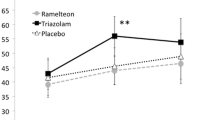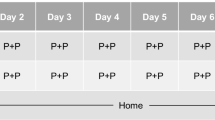Abstract
Rationale
Alprazolam extended-release (XR) is approved for the treatment of panic disorder. This sustained formulation is absorbed in a delayed manner and is therefore expected to produce fewer and less severe side effects than its immediate release equivalent (alprazolam IR). The effect of alprazolam XR on potentially dangerous daily activities, such as driving a car, is expected to be less as compared to alprazolam IR.
Objectives
The present study was designed to compare the effects of alprazolam XR (1 mg) and alprazolam IR (1 mg) on actual driving ability and cognitive function.
Method
Eighteen healthy volunteers (aged 20–45 years) participated in a double-blind, placebo-controlled, three-way crossover study. At 4 h post-dose, subjects performed a standardized driving test on a primary highway in normal traffic. Cognitive and psychomotor tests were assessed 1, 2.5, and 5.5 h post-dose. Memory functioning was measured only 1 h after administration.
Results
Both formulations severely impaired driving performance between 4 and 5 h after administration. The magnitude of impairment in the driving test observed with alprazolam XR was about half that observed with alprazolam IR. Laboratory test results were in line with the driving data.
Conclusions
The acute impairing effects of alprazolam XR 1 mg on driving and psychomotor functions were generally less, as compared to its immediate-release equivalent, but still of sufficient magnitude to increase the risk of becoming involved in traffic accidents.

Similar content being viewed by others
References
Barbone F, McMahon AD, Davey PG, Morris AD, Reid IC, McDevitt DG, MacDonald TM (1998) Association of road-traffic accidents with benzodiazepine use. Lancet 352:1331–1336
Bertz RJ, Kroboth PD, Kroboth FJ, Reynolds IJ, Salek F, Wright CE, Smith RB (1997) Alprazolam in young and elderly men: sensitivity and tolerance to psychomotor, sedative and memory effects. J Pharmacol Exp Ther 281:1317–1329
Borkenstein RF (1974) The role of the drinking driver in traffic accidents, the Grand Rapids study. Blutalkohol 11
Busto UE, Kaplan HL, Wright CE, Gomez-Mancilla B, Zawertailo L, Greenblatt DJ, Seller EM (2000) A comparative pharmacokinetic and dynamic evaluation of alprazolam sustained-release, bromazepam, and lorazepam. J Clin Psychopharmacol 20:628–635
Curran HV (1986) Tranquillising memories: a review of the effects of benzodiazepines on human memory. Biol Psychol 23:179–213
Eller MG, Della-Coletta AA (1990) Absence of effect of food on alprazolam absorption from sustained release tablets. Biopharm Drug Dispos 11:31-37
Ellinwood EH Jr, Heatherly DG, Nikaido AM, Bjornsson TD, Kilts C (1985) Comparative pharmacokinetics and pharmacodynamics of lorazepam, alprazolam and diazepam. Psychopharmacology 86:392–399
Fillmore MT, Rush CR, Hays L (2002) Acute effects of oral cocaine on inhibitory control of behavior in humans. Drug Alcohol Depend 67:157–167
Fleishaker JC, Phillips JP, Eller MG, Smith RB (1989) Pharmacokinetics and pharmacodynamics of alprazolam following single and multiple oral doses of a sustained-release formulation. J Clin Pharmacol 29:543–549
Glue P, Fang A, Gandelman K, Klee B (2006) Pharmacokinetics of an extended release formulation of alprazolam (Xanax XR) in healthy normal adolescent and adult volunteers. Am J Ther 13:418–422
Greenblatt DJ, Wright CE (1993) Clinical pharmacokinetics of alprazolam. Therapeutic implications. Clin Pharmacokinet 24:453–471
Greenblatt DJ, Harmatz JS, Dorsey C, Shader RI (1988) Comparative single-dose kinetics and dynamics of lorazepam, alprazolam, prazepam, and placebo. Clin Pharmacol Ther 44:326–334
ICADTS (1999) Guidelines on experimental studies undertaken to determine a medicinal drug’s effect on driving or skills related to driving. Bundes Anstalt fuer Strassenwesen (BASt), Köln
Isbister GK, O’Regan L, Sibbritt D, Whyte IM (2004) Alprazolam is relatively more toxic than other benzodiazepines in overdose. Br J Clin Pharmacol 58:88–95
Kroboth PD, Folan MM, Bauer KS, Tullock W, Wright CE, Sweeney JA (1998) Do alprazolam-induced changes in saccadic eye movement and psychomotor function follow the same time course? J Clin Pharmacol 38:337–346
Logan GD (1994) On the ability to inhibit thought and action: a users’ guide to the Stop Signal Paradigm. In: Dagenbach D, Carr TH (eds) Inhibitory processes in attention, memory, and language. Academic, San Diego, pp 189–239
Louwerens JW, Gloerich ABM, de Vries G, Brookhuis KA, O’Hanlon JF (1987) The relationship between drivers’ blood alcohol concentration (BAC) and actual driving performance during high speed travel. Alcohol Drugs Traffic Saf 86:183–186
Moroz G (2004) High-potency benzodiazepines: recent clinical results. J Clin Psychiatry 65(Suppl 5):13–18
Moskowitz H (1973) Laboratory studies of the effects of alcohol on some variables related to driving. J Saf Res 5:185–199
Mumford GK, Evans SM, Fleishaker JC, Griffiths RR (1995) Alprazolam absorption kinetics affects abuse liability. Clin Pharmacol Ther 57:356–365
Neutel CI (1995) Risk of traffic accidents injury after prescription for a benzodiazepine. Ann Epidemiol 5:239–244
Neutel I (1998) Benzodiazepine-related traffic accidents in young and elderly drivers. Hum Psychopharmacol Clin Exp 13:S115–S123
O’Hanlon JF (1984) Driving performance under the influence of drugs: rationale for, and application of, a new test. Br J Clin Pharmacol 18(Suppl 1):121s–129s
O’Hanlon JF, Ramaekers JG (1995) Antihistamine effects on actual driving performance in a standard test: a summary of Dutch experience, 1989–94. Allergy 50:234–242
O’Hanlon JF, Vermeeren A, Uiterwijk MM, van Veggel LM, Swijgman HF (1995) Anxiolytics’ effects on the actual driving performance of patients and healthy volunteers in a standardized test. An integration of three studies. Neuropsychobiology 31:81–88
Ramaekers JG (2003) Antidepressants and driver impairment: empirical evidence from a standard on-the-road test. J Clin Psychiatry 64:20–29
Ramaekers JG, Kuypers KPC (2006) Acute effects of 3,4-methylenedioxymethamphetamine (MDMA) on behavioral measures of impulsivity: alone and in combination with alcohol. Neuropsychopharmacology 31:1048–1055
Ramaekers JG, Louwerens JW, Muntjewerff ND, Milius H, de Bie A, Rosenzweig P et al (1999) Psychomotor, cognitive, extrapyramidal, and affective functions of healthy volunteers during treatment with an atypical (amisulpride) and a classic (haloperidol) antipsychotic. J Clin Psychopharmacol 19:209–221
Rey A (1964) L’examen clinique en psychologie. Presses Universitaires de France, Paris
Rickels K (2004) Alprazolam extended-release in panic disorder. Expert Opin Pharmacother 5:1599–1611
Robbe HW, O’Hanlon JF (1995) Acute and subchronic effects of paroxetine 20 and 40 mg on actual driving, psychomotor performance and subjective assessments in healthy volunteers. Eur Neuropsychopharmacol 5:35–42
RxList (2005) Top 200 prescriptions for 2005 by number of US prescriptions dispensed. http://www.rxlist.com/top200.htm
Scavone JM, Greenblatt DJ, Goddard JE, Friedman H, Harmatz JS, Shader RI (1992) The pharmacokinetics and pharmacodynamics of sublingual and oral alprazolam in the post-prandial state. Eur J Clin Pharmacol 42:439–443
Smith RW, Kroboth PD (1987) Influence of dosing regime non alprazolam and metabolite serum concentrations and tolerance to sedative and psychomotor effects. Psychopharmacology 93:105–112
Smith RB, Kroboth PD, Vanderlugt JT, Phillips JP, Juhl RP (1984) Pharmacokinetics and pharmacodynamics of alprazolam after oral and iv administration. Psychopharmacology 84:452–456
Subhan Z, Harrison C, Hindmarch I (1986) Alprazolam and lorazepam single and multiple-dose effects on psychomotor skills and sleep. Eur J Clin Pharmacol 29:709–712
Van Laar MW, Volkerts ER, Van Willigenburg APP (1991) Therapeutic effects and effects on actual driving performance of chronically administered buspirone and diazepam in anxious outpatients. J Clin Psychopharmacol 12:86–95
Vermeeren A (2004) Residual effects of hypnotics: epidemiology and clinical implications. CNS Drugs 18:297–328
Vermeeren A, De Gier JJ (1995) Methodological guidelines for experimental research in drugs and driving: accomplishments and future needs. In: Krüger HP, Kohnen R, Schoch H (eds) Medicamente im Strassenverkehr: Auftreten, Risiken Konsequenzen. Gustav Fisher Verlag, Stuttgart, pp 49–59
Vermeeren A, Jackson JL, Muntjewerff ND, Quint PJ, Harrison EM, O’Hanlon JF (1995) Comparison of acute alprazolam (0.25, 0.50 and 1.0 mg) effects versus those of lorazepam 2 mg and placebo on memory in healthy volunteers using laboratory and telephone tests. Psychopharmacology 118:1–9
Vermeeren A, Riedel WJ, van Boxtel CJ, Darwish M, Paty I, Patat A (2002) Differential residual effects of zaleplon and zopiclone on actual driving: a comparison with a low dose of alcohol. Sleep 25:224–231
Verster JC, Volkerts ER (2004a) Antihistamines and driving ability: Evidence from on-the-road driving studies during normal traffic. Ann Allergy Asthma Immunol 92:294–305
Verster JC, Volkerts ER (2004b) Clinical pharmacology, clinical efficacy, and behavioral toxicity of alprazolam: a review of the literature. CNS Drug Rev 10:45–76
Verster JC, Volkerts ER, Verbaten MN (2002) Effects of alprazolam on driving ability, memory functioning and psychomotor performance: a randomized, placebo-controlled study. Neuropsychopharmacology 27:260–269
Verster JC, Veldhuijzen DS, Volkerts ER (2005) Is it safe to drive a car when treated with anxiolytics? Evidence from on-the-road driving studies during normal traffic. Curr Psychiatry Rev 1:215–225
Vuurman EF, Uiterwijk MM, Rosenzweig P, O’Hanlon JF (1994) Effects of mizolastine and clemastine on actual driving and psychomotor performance in healthy volunteers. Eur J Clin Pharmacol 47:253–259
Acknowledgment
This research was supported by a grant from Pfizer, New York, USA.
We like to thank Anita van Oers, Janneke Guijaux, Roland Otten, Henk Brauers, Willy Jeurissen, Irma Brauers and Cees van Leeuwen for their assistance in data collection.
Author information
Authors and Affiliations
Corresponding author
Rights and permissions
About this article
Cite this article
Leufkens, T.R.M., Vermeeren, A., Smink, B.E. et al. Cognitive, psychomotor and actual driving performance in healthy volunteers after immediate and extended release formulations of alprazolam 1 mg. Psychopharmacology 191, 951–959 (2007). https://doi.org/10.1007/s00213-006-0669-8
Received:
Accepted:
Published:
Issue Date:
DOI: https://doi.org/10.1007/s00213-006-0669-8




